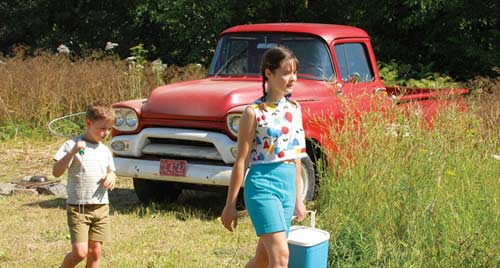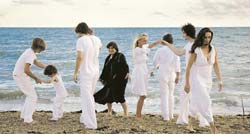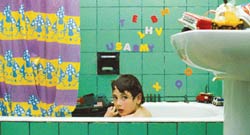
I first noticed director Lea Pool with her 1999 feature Set Me Free, about a girl on the edge of adulthood. Pool’s ability to portray and work with adolescents was powerful. So when I heard her latest film, My Mom’s at the Hairdresser, also dealt with children, I slotted it into my schedule. I’m glad I did, as she again obtains wonderfully naturalistic performances from her trio of stars.
In this case, the characters are three siblings--the oldest Elise, middle Coco (a boy), and youngest Benoit--starting summer in idyllic Quebec in 1966. Elise jumps off the school bus barefoot, ready to get going, Coco has plans to build his own go-cart, and Benoit ... well, Benoit is asking a lot of questions at the age of 5 or 6. The first third of the film is wonderfully comical, as Pool, working from a novel by Isabelle Hebert, captures how children play and interact. But the movie also realizes that children understand more than we give them credit for, that they watch adults and learn, in both good ways and bad.
As the film moves into more dramatic territory, it keeps things light with a string of hilarious and poignant scenes: children stuck in a closet while two adults have sex, Elise learning to fish by a river. The movie gets a bit too cute in places, such as twin girls talking in unison, but Pool understands the nostalgia she’s creating, especially in her brilliant use of radiant summer light. If that nostalgia makes it difficult for her to pull off a compelling ending, My Mom’s at the Hairdresser is still a satisfying contribution to the world of movies about kids.
Equally satisfying and funny is Agnes Varda’s latest whimsy, The Beaches of Agnes. An autobiographical documentary (or maybe an essay film, depending on how you categorize those things), it continues what Varda has been doing in Gleaners and I and Cinevardaphoto. The movie opens with a fantastic scene on a beach with mirrors, and it includes a beach delightfully created in the middle of a city street.
Most of the movie, though, tracks Varda’s development into a woman immersed in cinema, often by pairing her life story with examples from her film work. I found the first two-thirds of the film hilarious and insightful, in the way that only Varda can be. But as the movie entered the home stretch, I became a little bored. I’m not sure if it’s because I’m less interested in the post-‘60s time period or whether the material starts to lose its charm. Nonetheless, this is another vital work from a woman whose perspective on movies is always welcome.
Not as welcome and definitely not as funny, Salamandra is a loathsome debut from Argentinean director Pablo Aguero. He introduced the movie with three simple words: Enjoy ... or Suffer. And suffer I did. The film is a child’s-eye view on Argentina after the “Dirty War.†Inti’s mom has been released from jail but not the prison inside her head. So she claims Inti from grandma and heads for the craziest hippie commune in the south.
Aguero establishes a mood of dread that made me think we had entered Haneke territory. But Aguero doesn’t have the chops to pull that off, so he relies on a whole litany of transgressive provocations. I knew I couldn’t trust the movie when early on an animal is killed on screen for absolutely no reason, and things go downhill from there. It’s also deeply unsettling to watch the young actor (who can’t be more than six or seven years old) put into dangerous adult situations. At one point, he’s in a shower with a naked woman. At another point, someone pushes him around and spits in his face. I get the sense that Aguero just thought he’d poke a finger in the audience’s eye and giggle about it. I would’ve booed at the end, but I figured that’s what he wanted, and I didn’t want to give him the satisfaction.
As I write this, the festival has come to an end. But look for my final couple days of TIFF coverage in the week to come. And Rob should be around on Monday with his own perspective, so look forward to that.






J. Robert, thanks for your recommendation of My Mom's At the Hairdressers, which is part of the Mill Valley Film Festival this year and among the slate of press screenings.
In contrast to you, The Beaches of Agnes charmed me throughout. I would be curious to know exactly what it is in her later work that doesn't interest you or, more accurately, whenabouts that lack of interest commences for you. I'm very much looking forward to interviewing Varda when she makes a Bay Area appearance at PFA later this year, primarily to thank her for being so up front about what she felt during Demy's death from AIDS. My own partner of 12 years passed from AIDS and, like Varda, it is still a rupture that affects my daily activities and future creativities. The scene of her in three quarters profile with her back to the camera mourning the loss of her loved one, her body filled with waves, is one of the most eloquent expressions of grief I've ever seen. I have certainly felt it. I look forward to thanking her for expressing our shared experience.
As for Salamandra, I feel a need to defend the film because--with all due respect--I think you missed the point and have not given the filmmaker credit for his construction. As someone who grew up equally poor and whose early years lacked the kind of paternal containment presented in the film--an experience which Pablo Aguero himself shares--I think it quite accurately reflects the energy of survival, its aesthetic. No, this is not the way any child should grow up; but, it's the way many children have grown up, myself included. To dismiss it as "loathesome" is to discount the peculiar benefit of surviving in just this way. I am the individual I am today, as is Aguero, because of these difficult beginnings. Further, you grant him no discretion. The child actor--though it appeared he was in scenes with naked adults--never really was. These were tricks of the camera, shots and countershots, that Aguero skillfully choreographed precisely to protect the child actor's innocence. But to presume he was innocent as we would like to think of children as innocent is equally mistaken. Joaquin Aguila likewise grew up in this kind of environment and has a natural intensity and energy for survival expressed by his character Inti. The truth is that he acted the victim when he's probably more like the boy spitting in the other child's face. Aguero told me that he was often intimidated by Joaquin whose nearly feral ferocity forced Aguero to realize he was a force of nature not to be directed. One of the main things Aguero had to learn to do was to resist the impulse him to direct him, as if just because he was a child he did not have a sense of the film's thematic complexity. Further, when the film premiered at Cannes Joaquin and his family were brought to the festival and it was the first time they had ever been out of that Patagonian valley. They had never even traveled to Argentina's major cities before. Aguero said the family wept when they saw the Eiffel Tower. The point is, a child survives however he has to, but to become creative on top of that is an even more striking achievement. I speak from my own experience, as Aguero speaks from his, and as Joaquin speaks from his. I'm sorry you didn't like the film; but, I feel a need to defend it. I feel your assessment is most unfair.
Michael, I'm eager to read your interview with Aguero. Salamandra was one of the very last films I saw at the fest, and I regretted immediately that I'd passed on a chance to meet with him. I liked the film a great deal and would disagree with J. Robert on one point in particular. Salamandra is certainly filled with dread and anxiety but the comparison to Haneke isn't fair. I have some complaints about this film (and, Michael, the kid is in the shower with a topless woman -- we see them together in a single shot at the very end of the sequence), but Aguero definitely has chops. I can't wait to see what he does next.
I'm glad I saw Salamandra immediately after Treeless Mountain. I'm generally not a fan of "child in peril" films, even autobiographical ones, because, as narrative, they're just too easy. So Yong Kim puts her camera on cute little girls and we feel pity for them. It's that easy and that simple. Salamandra is a much more complicated animal. I liked a comment Aguero made after our screening: "When your life is in danger, you become more alive to the sensations around you." I'm really impressed by how effectively he renders those sensations in the film.
Rats. I wish I'd seen Salamandra so I could take sides. :-)
Darren, I agree with you about Treeless Mountain, although, for as simple as the formula seems, I rarely see such naturalistic performances from kids in movies. And I attribute that entirely to the atmosphere of the shoot, not to inherent acting ability. So Yong Kim cites Kore-eda's Nobody Knows as her inspiration, but I liked her film much better, if only because it lacks the portentous spilled nail polish (blood red, naturally) and the teetering chair. (Truffaut's Small Change has a particularly great take on the child in peril, by the way, and he riffs on these kid-leans-toward-high-window scenes in a way that has forever spoiled them for me.)
But, mild defense aside, I don't think Treeless Mountain is particularly rich. It feels more credible than Katia's Sister, which we saw shortly before, but also formally less interesting -- so on balance I think I like them about the same.
But maybe Salamandra will show up in Chicago.
The Varda film made me want to see Vagabond again. So did Wendy and Lucy, actually. I often think of that film, but I haven't actually watched it in quite a while. It's certainly her most demanding film, of the ones I've seen.
I thought her personal essay was nice throughout. She was friends with Jim Morrison and knows Chris Marker? How cool. And I can't believe that she's still so playful with cinema -- the walking backward, the mirrors. That's her daughter at the end of Umbrellas of Cherbourg!? Cool.
Did you all stay to the end of the credits? Two words: eighty brooms.
the kid is in the shower with a topless woman
Ah yes. Like Milos Stehlik at Facets, I can honestly say that I wanted to watch Salamandra all over again as soon as it was over. For me it was that richly textured, with so much going on, that it doesn't surprise me at all that I forgot that visual detail. But your reminder also leads me to consider that individuals think differently on what constitutes adult nudity. I'm talking more about bottomless nudity with specified sexual conduct, as when the naked man was chasing the naked woman around the house and--presumedly--Inti (and Joaquin as actor) was watching. It concerned me when I watched that scene and that's why I asked Aguero about it and that was the scene of adult nudity we discussed, not the scene in the shower. A topless woman with child seems harmless to me, especially when they're bathing. If anything, for me it's a given in any movie outside of America and as natural as nurturance. But everyone's got their own ideas of what they think is right and wrong behavior in front of a child and I certainly wouldn't want to question yours though I'm encouraged to qualify mine.
I'm generally not a fan of "child in peril" films, even autobiographical ones, because, as narrative, they're just too easy.
I find that a very curious statement, though I think I understand what you mean, even if it sounds a bit biased as one who had a safe childhood? I don't know your biography so I can't say. I do know that writing or filming about difficulties at the beginning is not as easy as it reads or views and I respect the therapeutic creativity of such candor. Remind me never to show you my autobiographical manuscript in process, Confessions Of A Demented Jaguar. God forbid I should be subjected to blithe dismissal when it's taken every bit of courage I have to discuss these events.
Robert, interestingly enough, it was Sandrine Bonnaire's performance in L'Empreinte de l'Ange that made me want to see Vagabond again. I'm hoping PFA will show same when Varda travels Bayside.
Holy cow, the mom in L'Empreinte de l'Ange (aka Mark of an Angel) is the vagabond! I knew she looked familiar. Thanks for making the connection, Maya. Were you as drawn into that cheesy movie as I was? I want to ask you what happens at the end (I had to leave a bit before it wrapped up), but don't tell me.
Michael, when I say "easy" I only mean that the artist is working with material that has an abundance of inherent potential for sentiment and/or provocation. I don't mean to imply that it was easy for So Yong Kim to revisit a difficult moment in her life, or that it was easy for her to get such wonderfully natural performances from the children. Far from it. Only that it's easy to "move" an audience with images of a child in danger, just as it's easy for a nature documentarian to move an audience by filming a cute little bunny that is unaware of the python slithering up behind it.
The general problem I have with "child in peril" stories is that I don't trust pity. I love something Godard said when he was asked about TV news coverage of the war in the Balkans: "At the same moment that we are looking, we forget." It's like those "Feed the Children" commercials. They're designed to provoke just enough pity in the viewer to make him or her pick up the phone and make a donation. But simple pity, at least when it's inspired by a middling film or advertisement, is too easily disposed of. At the same moment that we are looking, we forget.
That's what I liked so much about Salamandra. I don't think I ever felt pity for the boy, and if I did it was counterbalanced by several other emotions: admiration, fear, disgust, respect, curiosity, and on and on.
For the record, the tub scene didn't bother me, but as soon as it began I started looking for cuts. I was trusting enough of Aguero by that point that I was just interested to see how he would handle it.
Rob, what most intrigued me about L'Empreinte de l'Ange is its comparability to Vinyan, which I have yet to write up fully. They both feature mothers convinced a child thought dead is not dead and the drastic measures they take to confirm same. I was totally taken by the cheesey melodrama in both films, even as I found that central narrative theme in both unbelievable.
Darren, I understand what you mean now. Pity as disposable sentiment--in contrast to mobilized compassion, let's say--is a modern form of pornography. I agree.
In fact, as I think about that poor python slithering up behind the bunny rabbit, I am deeply concerned about its digestion. How manipulative of that nature documentarian!
"Pity as disposable sentiment — in contrast to mobilized compassion, let's say — is a modern form of pornography."
Well said.